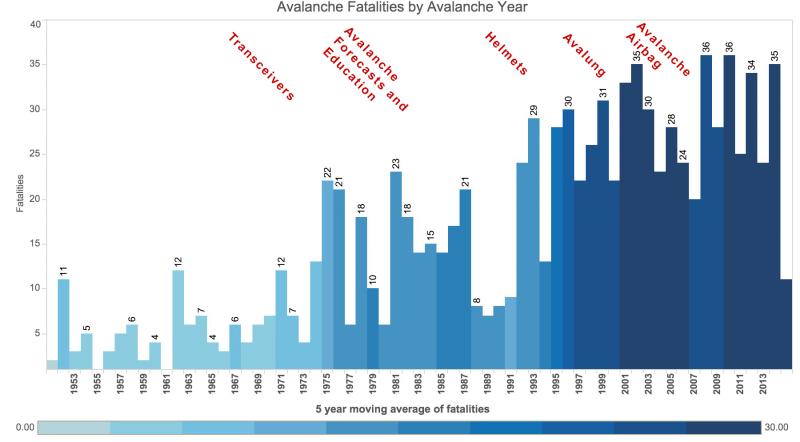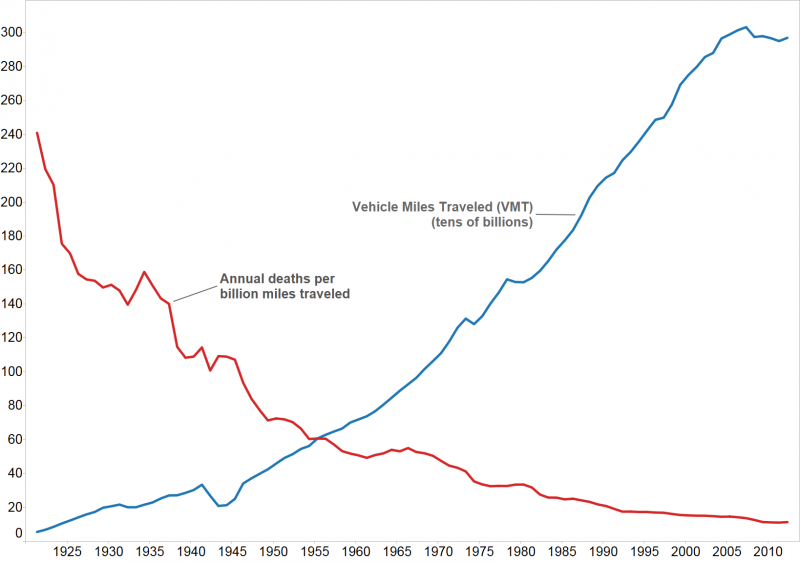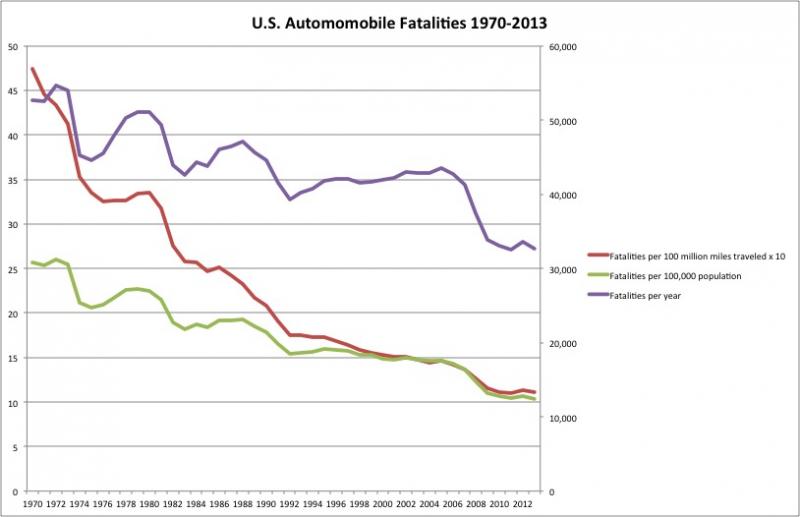
When I wrote the blog on the effectiveness of avalanche airbags, I was surprised that most of the comments revolved around risk homeostasis. So what the heck is risk homeostasis? Let me tell you a little story….
I was just a youngster, around 5 years old, at the family cabin on Flathead Lake in Montana where we spent all our summers growing up. My mother had just purchased a newfangled substance—mosquito repellent—and she sprayed it on my exposed skin and explained that the “buggies wouldn’t bite me anymore.” Wow, I remember thinking. What an amazing, magical substance. Of course, the first thing that came to mind was the big wasp nest in the bushes behind the cabin, because those wasps always tormented us in late summer (and still do). I wasted no time. I sprinted up to the wasp nest and gave it a big kick. I still remember the grand sight of it flying through the air, tumbling end over end with swarms of wasps streaming out of it. I held out my arms in the smug anticipation of the swarm being hurled back by the repellent, but everything quickly turned to horror as they instantly smothered me with stings. Screaming, I ran to the lake and dove in. My mother felt horrible, of course, but she wasn’t altogether surprised by my behavior.
I learned a great lesson that day about a concept that would later serve me well; technology and safety measures that make us feel safer can encourage risky behavior, which can nullify any of its benefits. These days, scientists have names for it—risk homeostasis, risk compensation or the Peltzman effect.
First, I should say that I’m an avalanche geek, not a social scientist, so I’m drifting well away from my expertise here. But this subject has interested me for many years and in doing all the casual reading and background research, it became quickly clear the even the experts don’t agree. So I’m not trying to definitively answer any questions here but just to give a short primer on the subject and hopefully elicit some reflection and discussion.
The counterintuitive and controversial concept of risk homeostasis was made popular by Gerald Wilde in his 1982 book Target Risk. (You can download an updated edition of it for free at: file:///Users/bruce/Downloads/targetrisk3_1.pdf) He makes the point that safety measures are much less effective than we expect because we simply increase our level of risk to get back to our normal risk tolerance level. We all have risk “set points” where, below a certain level level, we feel bored and above a certain level we feel scared. Risk-tolerant people feel comfortable with high risk and risk-intolerant people feel comfortable with much lower risk. For instance, if we buy a safer car, we just drive faster and more aggressively, which can nullify any benefit from safety measures.
In other words, if the concept of risk homeostasis is correct, then transceivers, avalanche education, avalanche forecasts, helmets, Avalungs and avalanche airbags (listed in roughly chronological order of their introductions) have not decreased the number of avalanche deaths because the perceived increase in safety causes more people to recreate in avalanche terrain and/or they recreate in riskier ways. All we have to do is look at the graph of avalanche deaths in the U.S. to see that this is true.

Total U.S. avalanche fatalities along with the years that various safety equipment and safety measures were introduced. At first glance, they have not been particularly effective, but first we have to take into account that populations have exploded in most western resort communities and that several new user groups started recreating in avalanche terrain. Snowmobilers accounted for half of the fatalities starting in the 1990's.
But to test the theory, it’s unfair to just look at the total number of fatalities because population in western resort communities has exploded in the past 40 years, plus, better equipment allows more people to easily access avalanche terrain. No one argues that there are many more people in avalanche terrain these days. The number we really want to know is avalanche fatalities per capita, or better yet, the number of fatalities per user day. Then, we would have a better idea whether riskier behavior diminishes the effectiveness of safety devices.
In the avalanche world, though, we just don’t have enough data to know if safety equipment either increases or decreases risk on an individual basis because we have no reliable numbers on how many people recreate in avalanche terrain and how often. Few reliable trailhead and ski resort exit gate surveys exist. Similarly, sales of backcountry equipment is also an unreliable indicator because we don’t know how often existing users buy new equipment. For instance, backcountry-specific snowmobile sales skyrocketed for a few years after manufactures came out with high power, lightweight, long-track sleds but then flattened out or even decreased, possibly because many people continued to use the sleds they already owned instead of purchasing ones with an incremental improvement in technology. Plus, we don’t know how the Great Recession affected sales. We can do back-of-the-napkin calculations all we want but the truth is that we just don’t know whether avalanche safety measures have increased or decreased the accident and fatality rate and by how much.
If that’s not complicated enough, it’s not just about risk. Economists use the concept of a “utility curve”, meaning that increased safety also allows people to gain more utility (something useful to us). The most oft-cited case is for automobiles because we have such reliable data: Since 1970, with the addition of seatbelts, airbags, guardrails, better crash resistance, people got more utility by driving 54 % more miles today than in 1970. Even though we drive farther and faster, automobile fatalities have steadily decreased, through the years by whatever measure you use. Total automobile fatalities decreased by 38%, Fatalities per capita decreased by 60% and fatalities per mile driven decreased by 77%. In other words, we got something useful out of safety measures besides increased safety: we drive farther and faster than ever before. How cool is that? Likewise, in the avalanche world, we can now get more powder huck more cliffs and post more heroic videos on social media.
 Looking at the right side of this graph, when seatbelts, airbags, antilock brakes, guardrails and other safety measures started to be added to cars around 1970, deaths per mile traveled has decreased while miles traveled per vehicle strongly increased. We not only got safer automobiles but we also gained utility from the safety devices--we drove faster and farther.
Looking at the right side of this graph, when seatbelts, airbags, antilock brakes, guardrails and other safety measures started to be added to cars around 1970, deaths per mile traveled has decreased while miles traveled per vehicle strongly increased. We not only got safer automobiles but we also gained utility from the safety devices--we drove faster and farther.
 By whatever measure you use, driving is safer now than in 1970.
By whatever measure you use, driving is safer now than in 1970.
And here’s another twist: The concept of risk compensation is controversial because not all studies show an increase in risky behavior. It turns out different types of safety measures cause different amounts of risk compensation. Check out the scientific paper from James Hedlund titled, “Risky business: safety regulations, risk compensation, and individual behavior.” (http://www.ncbi.nlm.nih.gov/pmc/articles/PMC1730605/pdf/v006p00082.pdf).
He found that the amount of risk compensation that occurs with safety equipment depends on several criteria: visibility, effect, motivation and control. To paraphrase his criteria: safety equipment encourages more risky behavior when:
1) It reminds us regularly that we’re using it
2) We’re doing an activity where we’re motivated to increase risk by having more fun and/or gaining more utility.
3) We have control over our actions, for instance, a recreation setting instead of on the job where rules are inflexible.
With avalanche airbags, for instance, it fulfills all the criteria; we have to arm them each time we use them, they are heavier, thus, the equipment reminds us regularly that we’re that we’re using safety equipment. We participate in an activity that motivates us for steeper slopes, deeper snow and riskier decisions, and finally, we have control over our actions. So the risk compensation with airbags is probably higher than for more passive equipment such as a RECCO chip sewn into our clothing. Perhaps a transceiver would fall somewhere in the middle.So here’s the answer you’re probably after: According to research reviews from other fields, there are few scientifically documented cases in which adding safety equipment actually caused an increase in fatalities or accidents. But in most cases, it simply does not increase safety as much as we would expect because people tend to compensate for it by either increasing risk and/or gain more utility. (I can’t seem to find the good scientific literature review I read a couple years ago that supports this claim but here’s one that’s similar:http://www.tandfonline.com/doi/abs/10.1080/10286580008902554)
People often cite many examples of non-scientific observations, such as to compare the injury rate of football to rugby and boxing to bare-knuckled fighting. In both cases, concussions and serious injuries are much worse in the sports with safety equipment. But, of course, you’re comparing apples to oranges because they’re different sports with different rules and different kinds of players. A better way to study risk compensation would be to do a “naturalistic” experiment in which you would take the helmets and pads from the NFL and give them to professional rugby teams. Then sit back for a few years and see what happens. (This seems like a great idea for a new spectator sport.) What makes it more complicated is that risk compensation not only occurs among individuals but groups as well. Would the sport of football quickly evolve to look more like rugby and vise versa?
I often hear debates whether avalanche education and avalanche forecasts promote more people to recreate in avalanche terrain; even if individuals may be safer, the perception of safety may encourage more people to participate, which translates into more total avalanche fatalities. Plus, the addition of safety equipment can create brand new sports: when parachutes were invented to save the occupants from crashing planes, soldiers and firefighters quickly figured out how to get some utility from them and many new sports sprung up as well. And, of course, people speculate that since modern snowmobilers wear a very stout helmet plus pads roughly similar to a hockey player, if you add an avalanche airbag, will a new sport emerge—avalanche riding? Has it already?
Pascal Haegeli specifically addressed risk compensation in his article on the effectiveness of avalanche airbags in his Avalanche Review article. I especially like his summary “…the risk reduction gained from the use of an airbag is roughly equivalent to the risk increase from being involved in an avalanche of one size class larger. This clearly shows that personal safety benefits from airbags are quickly nullified if individuals use them to justify increased exposure to terrain that is capable of producing larger avalanches.”
Personal anecdotal evidence:
I know that anecdotal evidence is not science and it usually counts for nothing, but here’s my experience from a 40-year avalanche career: Like most people, I know that I have jumped into slopes that I would have avoided if I were not wearing a transceiver. Likewise, last season, we had a demo, JetForce avalanche airbag pack from Black Diamond that we passed around among our forecasters. Once I got my turn, I didn’t give it up for the rest of the season. I loved it. I especially liked the way the fan conspicuously turned on for a split second every time I armed it at the trailhead and the way I could see the blue lights flashing every time I looked down at the trigger handle. Yes, I felt safer. But I also realized that it was affecting my attitude. I felt more comfortable in larger, steeper, avalanche terrain, especially in low-consequence terrain where the airbag had a high chance of making a difference. I also noticed that my friends expected me to go first because I had an airbag. And I felt a little more naked after we had to send it back at the end of the season. So yes, I could feel the dark forces pulling at me.
But I also realized that the key was attitude adjustment. I needed to stick to my own Ulysses contract to never commit to avalanche terrain unless I’m 99.9% certain about the snowpack, which is the way I’ve avoided being caught in an avalanche for over a quarter century—so far anyway, knock, knock. I needed to ignore the siren song from my safety equipment. I needed to remember that the journey is the destination, that my motivation is not powder, peaks or prestige, but to come home safe each day. I also like to keep my safety equipment as invisible and routine as possible. For the transceiver, I put-it-on-turn-it-on each morning so that it’s just part of getting dressed. I like to wear a helmet without earflaps so most of the time I don’t know I’m wearing it. A friend of mine who has worked many years as a Canadian helicopter ski guide once told me, “Back in the old days when nobody wore helmets, people never hit trees. Now that everyone wears helmets, people hit trees all the time.” (See George Vargyas’s excellent blog.)
I’m still debating whether I should buy an airbag pack. I’m basically a big chicken in the mountains and I spend almost all of my time sticking to under 30 degree slopes except when I REALLY trust the snow and it’s low consequence terrain. So perhaps an airbag would be wasted on me. OK, my wife just read the last sentence and she doesn’t buy the argument. She knows how many mistakes I make. Maybe I’ll get one…eventually.
The Bottom Line:
Yes, most credible, scientific studies show that the use of safety equipment does, indeed, make us safer, but it often doesn’t provide the expected level of benefit because we tend to compensate for it by increasing our risk and/or increasing our utility (getting more powder, posting more heroic videos, inventing new sports or more people joining the sport). So the key to getting the maximum benefit from safety equipment is to also carefully control our attitude and behavior.
And for anyone who has tried to change your own attitude and behavior, or that of your kids or spouse, it’s easier said than done. But this is drifting seriously away from my expertise. Any takers on a blog?






